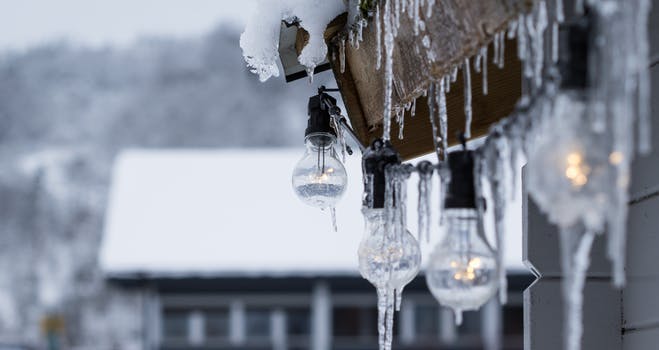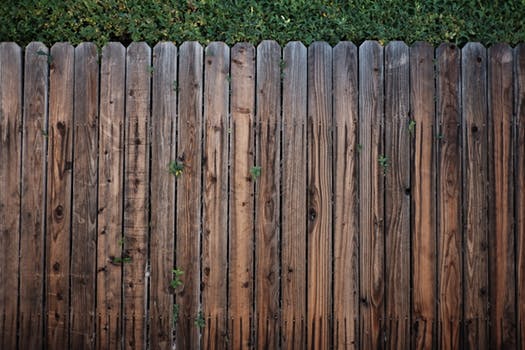Your home needs care and maintenance, year-round, and that can sometimes feel overwhelming. But, if you break it down into monthly to-do lists, then all becomes much more practical. Here is a list of items you want to consider; although it is not a comprehensive list of everything that ever needs done on a house (can you just imagine the size of that list?!?), it’s a useful home maintenance checklist. Note: because weather isn’t always predictable, tasks that are listed in October, for example, might be more appropriate in November if the temperatures are milder than expected. And, in many cases, you could switch out one month’s tasks for another; for example, doing April ones in May and vice versa.
January

Credit: Pexels
January is typically the coldest month in North Carolina, the time when your home is at the highest risk for frozen and even burst pipes. To keep pipes from freezing, insulate them with foam sleeves, paying particular attention to those in colder areas of your home like the basement, attic and garage. When leaving your home, keep your thermostat at 55 degrees or higher. And, if you’ve had experience with frozen pipes in the past and really don’t want to repeat the experience, let them drip slightly throughout the day. Your water bill may rise slightly, but running water is less likely to freeze than still water.
Pay close attention to your heating system during the coldest winter months. Even if you’ve had your furnace or other heating system inspected earlier in the year (you have, haven’t you?), the system may still develop problems after running constantly for months. Listen for unusual noises from the furnace and watch to see if there are areas in the home where the temperature has dropped for no obvious reason, and also watch for less efficient heating overall. If you suspect your heating system is having trouble, make sure it has been cleaned often enough and change the filters as necessary. If the problem persists, call a general handyman or HVAC professional for repairs. Also make sure that your carbon monoxide detectors are working properly to alert you to any problems.
February

Credit: Pexels
Winter hail can cause significant damage to your roof. While preventing hail damage altogether is difficult, you can act quickly after a hail storm to protect your home. Use binoculars to inspect the roof after a storm. If you find any marks, even small ones, or loose shingles, call a roofing service professional to repair the damaged areas. Leaving your roof damaged until warmer weather can lead to leaks, cracks and possibly permanent home damage.
Winter storms can also cover sidewalks and driveways with snow and ice. Though you’re undoubtedly tired of the freezing weather by February, make sure you keep up on your driveway, sidewalk and outdoor step maintenance throughout the winter. Not only do snowy, slippery pathways put your safety at risk, they can also make you liable if a visitor or passerby falls and is injured. Keep plenty of ice melt on hand and keep pathways clear after every winter storm. Be aware of black ice and address that as quickly as possible.
March

Photo by Julián Gentilezza on Unsplash
Spring is finally in sight, and it’s time to start dealing with the aftermath of winter. First, if you didn’t address any roofing issues over the winter, consider a professional roofing inspection. Winter weather can cause a surprising amount of damage in a small amount of time and it makes sense to schedule a roofing inspection by the pros to fix any problems before the heat and humidity of spring makes them worse.
Another important step to prepare for spring rains is cleaning your gutters. Clogged gutters can damage your home’s foundation and wood trim. Make sure your gutters and drains run freely and divert water away from the house. Check for debris in the downspout gooseneck and clean it out with a garden hose. Also look for loose asphalt particles, which may indicate roofing damage.
For many homeowners, March means the beginning of termite season. Keep a sharp eye out for winged insects swarming in or around holes in woodwork. If you see any sign of termites, call a pest control company immediately. Catching a termite infestation early could save you thousands of dollars in repairs.
April

Photo by Matt Jones on Unsplash
Look at your driveway and other pathways around your home to check for damage. The recurring freezing and thawing of winter can cause cracks that only worsen with time. Spring moisture can make existing cracks even worse, so inspect your pavement and schedule repairs early.
Winter weather can also damage paint jobs outside your home, leaving wood exposed to the elements. Exposed wood means rotting and structural damage, so pressure wash the outside of your home in spring. Then inspect the area for worn paint and touch up exposed areas.
In preparation for warmer weather, you should also schedule a professional inspection of your air conditioning system. Even if you don’t notice anything wrong with your cooling system, calling a professional to clean the coils, change the filters and check for damage can help your system run more efficiently and last longer. And, when summer heat hits, you’ll be prepared!
May

Credit: Pexels
As the weather heats up, it’s time to make sure your irrigation systems are in tip-top shape to conserve water and keep your lawn and plants healthy. To make sure your irrigation systems work properly, check all sprinkler heads for damage. Then, set up the system and run it manually through all zones, ensuring that each area operates correctly. To conserve water, make sure none of the sprinkler heads are spraying water against the street, sidewalk, porch or house.
Pests, particularly insects, are a common problem for homeowners throughout the spring and summer months. Stay bug-free by storing food in airtight containers, cleaning up food and crumbs immediately, and repairing leaks, cracks and holes in the home as soon as possible. The most important step you can take to prevent pests, or prevent a pest problem from becoming bigger, is scheduling a professional pest control inspection once a year.
June

Credit: Pexels
If you have a fence, make sure that the gates operate properly. Are there loose bolts or screws? Tighten them. Do you need to fix or replace any latches? If part of the purpose of the fence is to add a layer of protection to your home, its value is negated when the gates can’t be effectively secured.
Also walk around your home to look at your brickwork, especially at the mortar. Do you need to repair the joints because of cracks or damage? If so, clean the area first, because dirt and crumbling mortar are likely to exist, then replace the mortar, wearing rubber gloves when doing so.
When you do your walk-around, also inspect your screen doors. Are there holes? If so, patch them or – if needed – replace the screen because even relatively small holes can allow mosquitoes and other unwanted critters into your home.
If you have a patio or deck, what repairs are needed? As you walk over it, is the structure strong throughout or does something need repaired? Are guardrails in good condition, at least 36 to 42 inches tall? To protect the integrity of your deck, you should also stain or paint it regularly.
July

Credit: Pexels
If you use a fireplace in colder weather, now is the ideal time to inspect both the fireplace and the chimney since you won’t be using them in the summer. A caution: even if all looks good, it’s recommended that the chimney is professionally inspected, cleaned and repaired, as needed. If you have firewood stacked up outside for future use, critters might be nesting in the wood, so put on protective gloves and check.
What about the foundation of your home? The area around it? If low areas exist in the areas immediately surrounding your home, they will likely fill up with water, providing a perfect breeding ground for insects and damaging your foundation.
Is there any wood rot in exterior door frames? In window frames? You’ll want to repair them before wintertime. You’ll also want to wash the exteriors of all your windows, as well as the outside of your entire home.
Throughout the summer season, be sure to clean your air conditioner filter every two weeks, washing it with warm water or using a vacuum cleaner. Some newer systems have a self-cleaning function; if so, then congrats! Clean the A/C fan, as well, which involves turning off your system, removing the fan motor and then the fan – then cleaning the fan.
August

Credit: Pexels
As the dog days of summer hit, simply closing your curtains and blinds may not do enough to keep the sun from adding heat to your home. So, think about additional options, such as an awning, especially helpful on south-facing windows, or trellises by your west-facing windows. Trees and shrubs can be helpful, as well; if you plant them near air conditioning units to keep them cool, make sure you aren’t stifling the A/C unit’s airflow. Also look at your curtains and blinds. Have they faded to the degree that they need replaced?
And, speaking of trees, August is a good month to prune dead wood and the perennials in your garden. This will make your yard look especially nice for summer picnics on the lawn this year, and it will also prep your yard for next summer’s beauty.
This month is also the time when wasp activity reaches its peak – and when they tend to become most aggressive. So, to avoid stings, identify wasp nests and determine how to remove them. This should include spraying by the entrance of the nest as many times as necessary. While you’re at it, check again for stagnant bodies of water that would attract mosquitoes, and that includes checking planters, bird baths and the like.
September

While the weather is still nice, check your sidewalks for cracks, uneven areas and loose material. Fixing these issues before the slippery season arrives can help to prevent a significant fall: yours or someone else’s. Continue your inspection and fixes up to the entryway to your home. If you find small cracks, they can be fixed with epoxy.
Be proactive and make sure you have weather stripping around your windows and doors, and that caulking is in good shape.
This is a good time to clean your siding, if that’s what you have, and to take care of outside painting jobs not addressed in the spring, whether that means it’s time to put a fresh coat of paint on your entire house, or to paint window sills, trim, wood on the porch and the like.
Also make sure that outdoor flood lights are in good repair, especially important as daylight is lessening. If you recognize that you need to add or replace outdoor lights, do so before the weather gets too dicey.
October

Take a look at your garage. What cleaning needs done? What painting? How can you better organize it to make better use of the space? Are garage doors opening easily? Are the lights on the garage in good working order? Are there any electrical repairs that need done?
Keep up with leaf raking so it doesn’t get away from you and determine what outdoor furniture you’ll need to move indoors, and which pieces can simply be covered. What about outdoor grills? Even if the weather is still mild, this will help to protect the finish from rain, hail and snow.
As temperatures drop, determine when you’re going to disconnect and drain outdoor hoses, and when to shut off water supply to these faucets so you don’t have to deal with frozen, even burst, pipes in the coming months.
November

If you haven’t already begun prepping your home for winter, November is the time to start. If you haven’t yet scheduled your annual roof inspection, now is the time. Any weaknesses in your roof, such as loose or missing shingles, loose flashing, or cracked caulk or tar can lead to significant damage if left unchecked.
Also take steps to prevent ice dams on your roof before the weather turns freezing. Because the edges of your roof are colder than the middle, ice can begin to build up around the eaves to create a dam. Ice dams trap snow and water on your roof and can cause permanent damage, so take action early. Before winter weather sets in, clean your gutters and make sure your attic is properly insulated. Buy a roof rake and clean the snow from your roof after heavy snowfall or winter storms (note: we recommend a professional roofing service for any tasks that would involve being on the roof).
This task is small but often overlooked in home maintenance: check the batteries in your smoke and carbon monoxide detectors throughout the winter. As people use candles, fireplaces and space heaters more often in the winter months, families are more at risk for house fires and carbon monoxide poisoning.
December

What would you do if a large winter storm took out your power for several days? Do you have a plan? Before your area receives any significant snowfall, stock up on emergency supplies: at least three days of drinkable water and shelf-stable foods, a hand-crank radio, flashlights with batteries, first aid supplies and possibly a generator.
Pay attention to your trees during winter time. After snowfalls of significance, use a broom or roof rake to brush snow off tree branches, paying special attention to those near your home. Avoid shaking the branches or pulling them down while you sweep, as you could cause a brittle branch to break.
Also stay alert for any leaks in your home. If you feel a cold draft in a certain area, or if one room stays particularly cold no matter how high you set your thermostat, you may have a leak. Check weather stripping on doors and windows, and caulking around doors, windows, air vents and plumbing that intersects a wall. Make repairs early to keep your heating bills down.
Charlotte General Handyman Services/Roofing Services
Maintaining your home can be time-consuming, so it’s understandable when you need help because your schedule gets busy, or when you don’t have the appropriate tools to complete a job, or when you don’t feel comfortable with the task (such as climbing a tall ladder to inspect your roof).
We are general contractors specializing in roofing services so, when you’re in need of general handyman services in the Charlotte or Raleigh, North Carolina area, contact Camden Roofing and Construction! Our services include:
- Masonry
- Hardwood/Carpet/Flooring
- Gutter Cleaning or Repair
- Siding
- Hang & Change Flood Lights
- Ceiling Fan Installation
- Light Installation
- Garage Doors
- Housekeeping Services
- Landscaping/Lawn Care
- Appliance Repair
- Electrical (install or repair switches)
- Drywall Repair
- Painting
- Garbage Disposals
- Carpentry (decks, porches, cabinets)
- HVAC
- Concrete (Driveways & Patios)
And, of course, we’re your go-team for complete roofing services!
Don’t delay! Contact us online or call us at 704-858-2141.



Leave A Comment
You must be logged in to post a comment.